To capture nature's splendor from above with drones, you'll need the right equipment and knowledge. Choose a drone with a high-resolution camera, long battery life, and stability features. Familiarize yourself with local regulations and obtain necessary certifications. Scout stunning locations, considering seasonal changes and lighting conditions. Master flight techniques and composition principles for compelling shots. Pay attention to weather, especially wind and lighting. Process your photos to enhance their beauty, and always practice ethical drone photography. By following these guidelines, you'll be well on your way to creating breathtaking aerial nature images. The sky's the limit for what you can achieve with drone photography.
Choosing the Right Drone
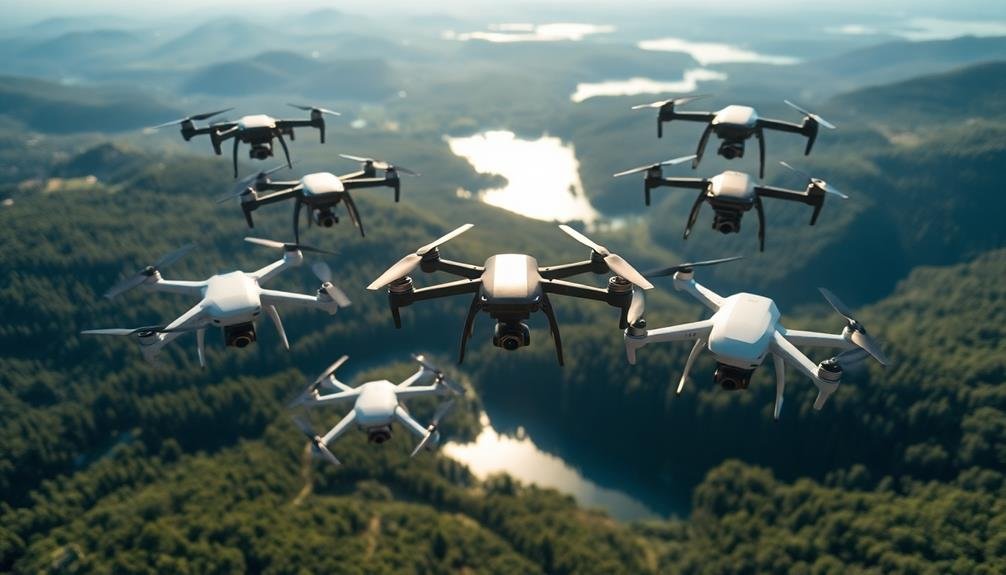
When selecting a drone for nature photography, it's important to take into account several key factors. First, consider the camera quality. Look for drones with high-resolution cameras, preferably 4K or higher, to capture stunning details in landscapes and wildlife.
Opt for models with adjustable camera settings, allowing you to control exposure, ISO, and shutter speed for best results in varying light conditions.
Flight time is vital, as longer battery life means more opportunities to capture the perfect shot. Choose a drone with at least 25-30 minutes of flight time per battery.
Portability is another significant aspect, especially if you'll be hiking to remote locations. Foldable drones are ideal for easy transportation.
Don't overlook the drone's stability and wind resistance. Nature can be unpredictable, so select a model that can handle moderate winds and maintain steady flight.
Advanced features like obstacle avoidance and GPS tracking can help protect your investment and improve your shooting capabilities.
Lastly, consider your budget and skill level. While high-end drones offer superior features, there are excellent options for beginners and intermediate users that won't break the bank.
Understanding Drone Regulations
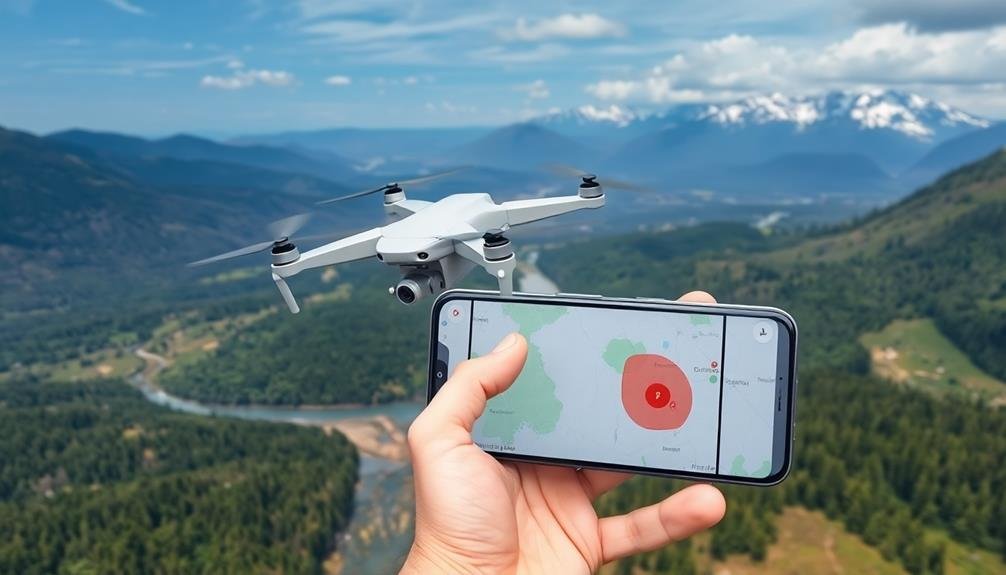
Before you take flight, you'll need to familiarize yourself with drone regulations.
Check local airspace restrictions and obtain necessary permits to guarantee you're flying legally in your chosen nature photography locations.
You'll also want to look into drone pilot certification requirements, as many countries mandate specific licenses for operating unmanned aerial vehicles.
Airspace Restrictions and Permits
Maneuvering the complex web of airspace restrictions and permits is crucial for drone photographers. You'll need to familiarize yourself with different airspace classifications and their associated rules. Class G airspace is typically open for drone operations, while Classes A, B, C, D, and E often require prior authorization.
Before flying, check for temporary flight restrictions (TFRs) in your area. These can be imposed for various reasons, including wildfires, sporting events, or VIP movements.
You'll also need to be aware of no-fly zones around airports, military bases, and national parks.
Many countries require drone operators to obtain permits for commercial photography. Even if you're flying recreationally, you may need special permission in certain areas.
Research local regulations and apply for necessary permits well in advance of your planned shoot.
Use apps like B4UFLY or AirMap to check airspace restrictions in real-time. These tools can help you identify controlled airspace, TFRs, and other flight limitations.
Drone Pilot Certification Requirements
The labyrinth of drone regulations can be intimidating, but understanding pilot certification requirements is vital for legal and ethical nature photography. In the United States, the Federal Aviation Administration (FAA) mandates that commercial drone pilots obtain a Remote Pilot Certificate. To get this, you'll need to pass the Part 107 knowledge test, which covers airspace regulations, weather patterns, and drone operation.
Even if you're flying recreationally, you must register your drone with the FAA and pass a basic aeronautical knowledge test. You'll also need to carry proof of registration when flying. Many countries have similar requirements, so research local laws before traveling abroad with your drone.
Keep your skills sharp and stay updated on changing regulations. The drone industry evolves rapidly, and rules can change. Consider joining a local drone club or online community to stay informed and share experiences.
Essential Aerial Photography Equipment
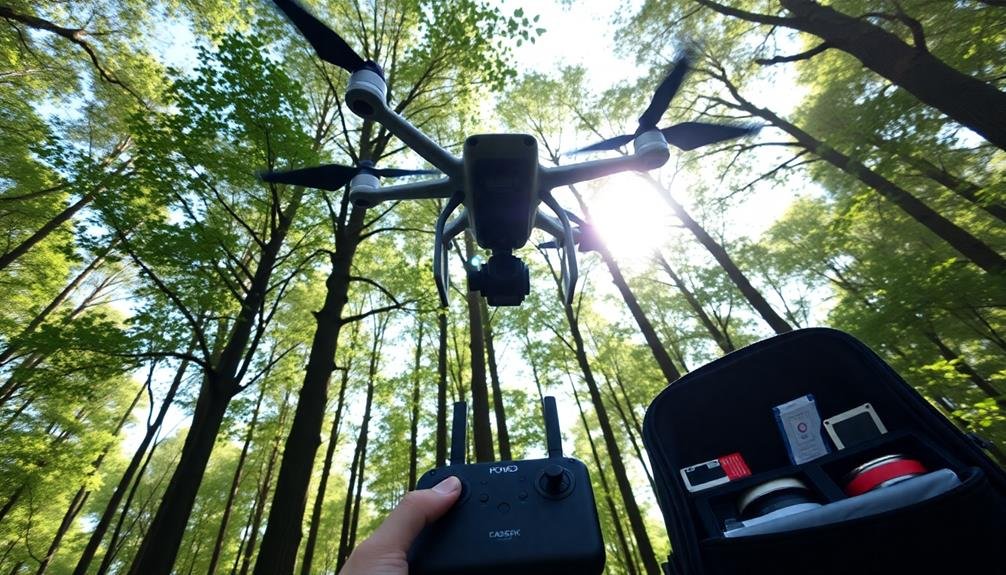
To capture stunning aerial nature shots, you'll need to equip yourself with the right tools.
Start by selecting a drone that suits your skill level and photography needs, then consider which camera and lens combinations will best achieve your desired results.
Don't forget to invest in essential accessories like extra batteries, propellers, and a sturdy carrying case to protect your gear during outdoor adventures.
Choosing the Right Drone
Selecting a drone for nature photography is a significant decision that can make or break your aerial imaging adventures.
You'll want to take into account several factors when choosing the right drone for your needs. First, look at the camera quality. A drone with a high-resolution camera, ideally 4K or higher, will capture stunning details of landscapes and wildlife. Pay attention to the sensor size and lens quality as well.
Flight time is another vital aspect. Longer battery life means more time to capture the perfect shot. Aim for drones with at least 25-30 minutes of flight time.
Take into account the drone's range too, as you'll often need to fly far to reach remote natural locations.
Portability is key for nature photographers who hike to their shooting locations. Foldable drones are easier to pack and carry.
Don't forget about stability and wind resistance, which are essential for smooth footage and clear images.
Camera and Lens Options
In light of the importance of image quality for nature photography, choosing the right camera and lens setup for your drone is essential. Most consumer drones come with built-in cameras, but for professional-grade results, you'll want to take into account upgrading to a high-quality camera with interchangeable lenses.
Look for cameras with at least 20 megapixels and the ability to shoot in RAW format. This will give you more flexibility in post-processing. For lenses, wide-angle options are popular for capturing expansive landscapes. A 24mm equivalent lens is a good starting point, but you might also want to think about ultra-wide options like 16mm or even fisheye lenses for unique perspectives.
Don't forget about image stabilization. While many drones have built-in gimbals, additional in-camera or in-lens stabilization can help guarantee crisp images, especially in challenging weather conditions.
If you're planning to shoot video, look for cameras that offer 4K resolution at 60 frames per second or higher.
Lastly, take into account the weight of your camera setup. Heavier equipment will reduce your drone's flight time and may require a more powerful drone model.
Essential Accessories and Attachments
Beyond the camera and lens setup, you'll need several key accessories to maximize your nature photography drone experience. First, invest in high-quality ND filters to control light exposure in bright conditions, allowing you to maintain slower shutter speeds for smoother footage.
A polarizing filter is essential for reducing glare and enhancing colors, especially when shooting water or foliage.
Don't forget extra batteries and a multi-battery charger to extend your flight time. A rugged carrying case will protect your equipment during transport. For precise landings in uneven terrain, consider landing gear extensions or a landing pad.
To expand your creative possibilities, look into specialized attachments like a 360-degree camera mount or a light panel for low-light situations. A tablet mount for your controller will provide a larger screen for better visibility and control.
For post-processing, a portable hard drive is vital for backing up your footage in the field.
Scouting Stunning Natural Locations
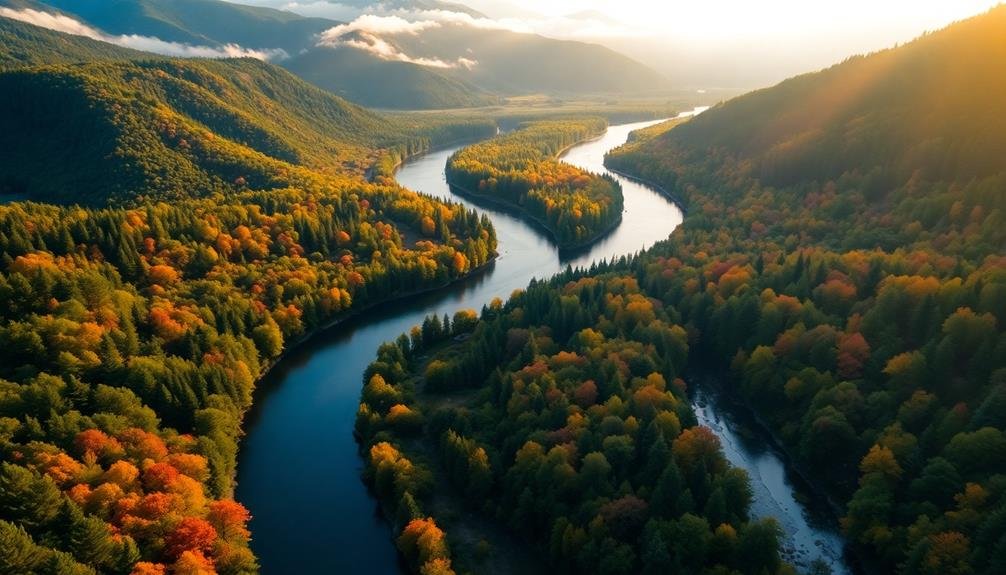
To capture breathtaking nature shots with your drone, you'll need to find the perfect locations. Start by researching online resources like Google Earth, Instagram, and local photography forums to discover promising areas. Look for diverse landscapes, unique geological formations, and vibrant ecosystems that'll stand out from above.
Consider the time of day and season when planning your shoot. Golden hour lighting can transform ordinary scenes into magical vistas, while autumn foliage or spring blooms add splashes of color. Don't overlook water features like rivers, lakes, and coastlines, as they often create stunning patterns and reflections.
When scouting in person, arrive early to assess the terrain and potential hazards. Look for elevated vantage points that'll give your drone a clear line of sight and safe takeoff area. Pay attention to wind conditions and obstacles like trees or power lines that could interfere with your flight.
Remember to respect nature and follow local regulations. Some protected areas may restrict drone usage, so always check beforehand.
Weather Considerations for Drone Flights

When planning your drone flight for nature photography, you'll need to carefully consider weather conditions.
Wind and turbulence can considerably affect your drone's stability and flight path, potentially compromising image quality and safety.
Additionally, you'll want to assess lighting conditions, as they greatly impact your photographs' exposure and overall aesthetic.
Wind and Turbulence Effects
Wind and turbulence pose two major challenges for drone operators in nature photography. You'll need to understand how these factors affect your drone's stability and image quality to capture stunning aerial shots.
Strong winds can push your drone off course, making it difficult to maintain your desired composition. They also drain your battery faster as the motors work harder to compensate. Turbulence, often caused by uneven terrain or thermal updrafts, can create sudden jerky movements, resulting in blurry images.
To mitigate these effects, consider the following:
| Wind Speed (mph) | Turbulence Level | Recommended Action |
|---|---|---|
| 0-5 | Low | Safe to fly |
| 6-10 | Moderate | Use caution |
| 11-15 | High | Experienced pilots only |
| 16-20 | Severe | Avoid flying |
| 20+ | Extreme | Do not fly |
Always check weather forecasts before your shoot. If conditions are less than ideal, use a higher shutter speed to reduce motion blur. Position yourself upwind of your subject to maintain better control. In areas prone to turbulence, fly at a higher altitude where air movement is more stable. Finally, invest in a drone with advanced stabilization features to help counteract wind and turbulence effects.
Lighting Conditions Impact
Lighting conditions play an essential role in drone nature photography, often making or breaking your shot. You'll need to take into account the time of day, weather, and seasonal changes to capture stunning images.
The golden hour, just after sunrise or before sunset, offers warm, soft light that enhances landscapes and wildlife. However, you'll face challenges with longer shadows and potentially reduced visibility for your drone.
Midday sun can create harsh contrasts and washed-out colors, but it's ideal for capturing water reflections or highlighting textures in desert landscapes. Overcast days provide diffused light, perfect for forest scenes or capturing subtle color variations.
You'll want to avoid flying in heavy fog or mist, as it can interfere with your drone's sensors and reduce image quality.
Seasonal changes affect lighting too. Summer offers long days but can produce hazy conditions, while winter's low sun angle creates dramatic shadows.
Spring and fall often provide the best lighting for vibrant foliage shots. Always check local weather forecasts and plan your flights accordingly.
Mastering Drone Flight Techniques
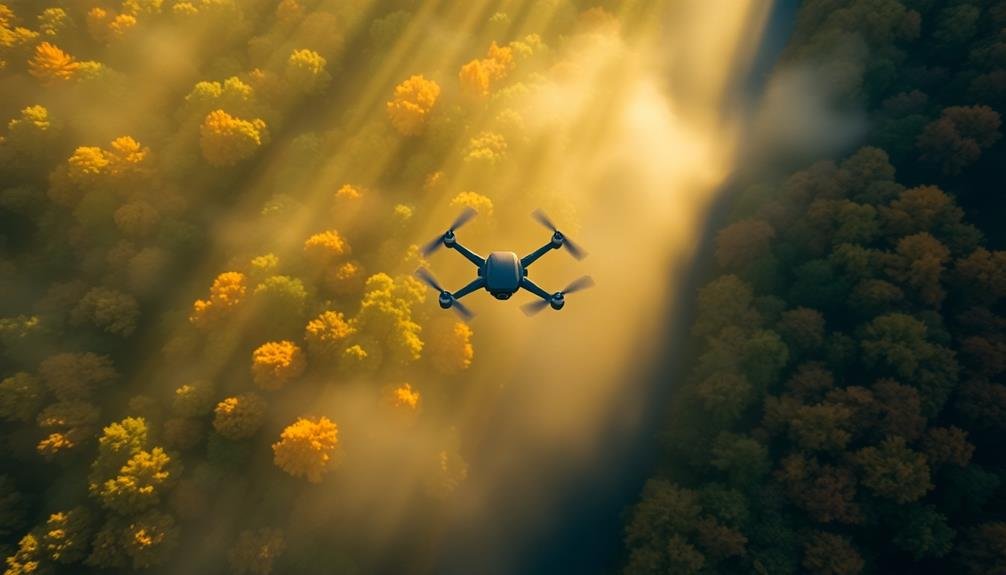
The key to capturing stunning nature shots with your drone lies in mastering essential flight techniques. Start by practicing smooth and controlled movements. Use gentle stick inputs to achieve fluid motions, which will result in more professional-looking footage.
Learn to hover steadily, as this skill is vital for capturing sharp images and stable video. Master the art of flying at different altitudes. Low-altitude flights can provide intimate views of landscapes, while higher altitudes offer breathtaking panoramas.
Experiment with various flight patterns, such as circular orbits or straight lines, to add dynamism to your shots. Familiarize yourself with your drone's intelligent flight modes, like tracking, waypoints, and point of interest. These can help you capture complex shots with ease.
Don't forget to practice flying in different weather conditions, as wind and temperature can affect your drone's performance. Always prioritize safety. Be aware of your surroundings, avoid no-fly zones, and respect wildlife.
Composition Principles for Aerial Shots
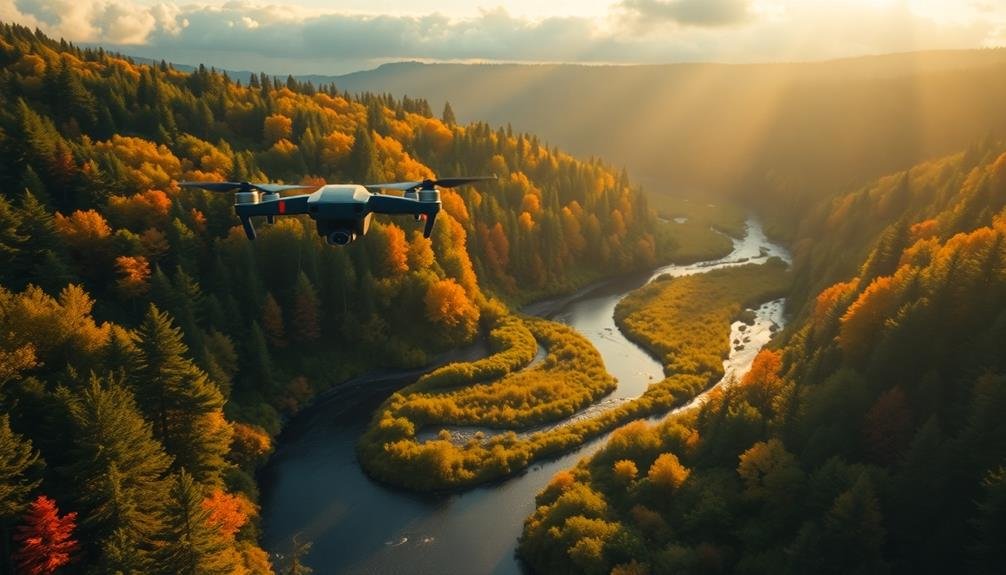
Crafting compelling aerial compositions requires a fresh perspective on traditional photography principles. When you're shooting from above, you'll need to contemplate unique elements like patterns, symmetry, and leading lines that may not be apparent from ground level. Pay attention to the interplay of light and shadow, which can create striking contrasts and textures in your aerial shots.
To enhance your compositions, use the rule of thirds to position key elements off-center, creating a more dynamic and visually appealing image. Look for natural frames within the landscape, such as rivers or tree lines, to draw the viewer's eye to your main subject. Don't forget to experiment with different angles and altitudes to find the most captivating perspective.
| Composition Technique | Description | Example |
|---|---|---|
| Leading Lines | Use natural or man-made lines to guide the viewer's eye | Winding roads, rivers |
| Symmetry | Create balance by finding mirror-like reflections | Lakes, architectural structures |
| Patterns | Identify repeating shapes or textures | Crop fields, urban layouts |
Remember to contemplate the drone's altitude and camera angle when composing your shot. Lower altitudes can provide more intimate details, while higher altitudes offer a broader, more abstract view of the landscape.
Capturing Golden Hour Landscapes
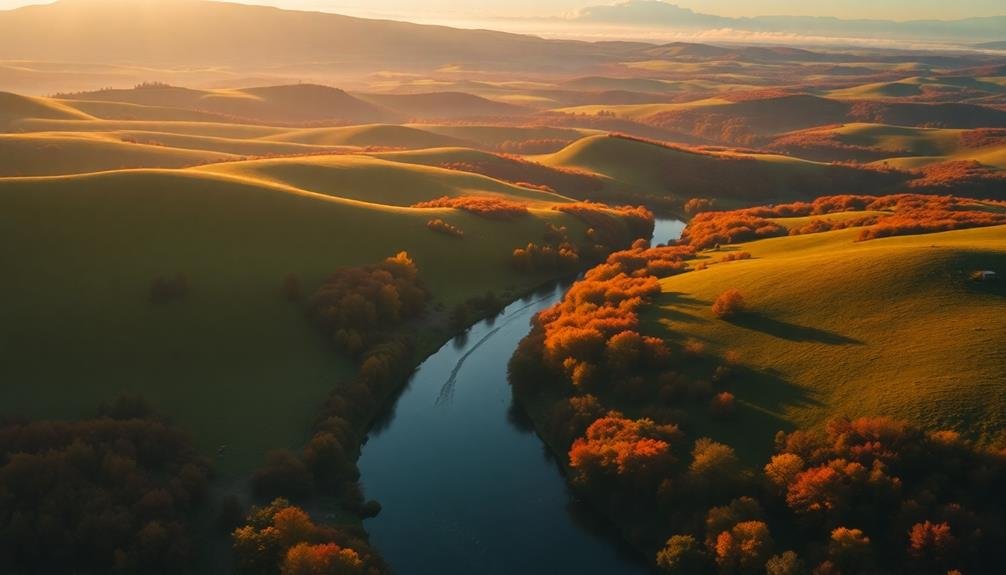
While mastering aerial composition techniques is fundamental, timing your shots can elevate your nature photography to new heights. The golden hour, occurring just after sunrise and before sunset, offers unparalleled opportunities for capturing breathtaking landscapes with your drone.
During this magical time, the sun's low position creates long shadows, warm hues, and soft light that can transform an ordinary scene into something extraordinary. To make the most of golden hour landscapes, you'll need to plan ahead. Research your location and determine the exact times for sunrise or sunset. Arrive early to set up your drone and familiarize yourself with the area.
As you capture golden hour landscapes, experiment with different angles and altitudes. Try shooting directly into the sun for dramatic silhouettes or perpendicular to it for side-lighting effects. Use your drone's camera settings to adjust exposure and white balance, ensuring you capture the warm tones accurately.
Don't forget to bracket your shots, as the dynamic range during golden hour can be challenging to capture in a single exposure. Finally, be mindful of local regulations and respect wildlife habitats when flying your drone during these sensitive times of day.
Post-Processing Aerial Nature Photos

After capturing stunning aerial nature photos, post-processing is essential to bring out the best in your images.
Start by importing your RAW files into your preferred editing software. Adjust the exposure, contrast, and highlights to enhance the overall balance of your photo. Pay special attention to the shadows, as aerial shots often have stark contrasts between light and dark areas.
Next, focus on color correction. Aerial photos can sometimes have a blue cast due to atmospheric haze. Use the white balance tool to neutralize any unwanted color tints and boost the natural colors of the landscape.
Don't forget to fine-tune the saturation and vibrance for a more striking image.
Consider these advanced techniques to elevate your aerial nature photos:
- Use selective adjustments to enhance specific areas of the image
- Apply noise reduction to minimize graininess in low-light shots
- Experiment with HDR merging for high-contrast scenes
Showcasing Seasonal Changes From Above

Drones offer a unique perspective for capturing nature's seasonal changes from above. You'll find that aerial photography can beautifully showcase the changing colors, textures, and patterns of landscapes throughout the year.
To effectively capture these seasonal shifts, plan your flights during shifting periods, such as early spring or late autumn, when the contrast between seasons is most apparent.
When shooting, look for areas that display a clear progression of change. For example, focus on forests evolving from lush greens to vibrant reds and golds, or capture the gradual melting of snow-covered fields.
Experiment with different altitudes to find the perfect balance between showcasing the broader landscape and highlighting intricate details.
To create a compelling narrative of seasonal change, consider revisiting the same location at regular intervals throughout the year. This approach allows you to build a series of images that tell a complete story of nature's annual cycle.
Don't forget to adjust your camera settings for each season's unique lighting conditions. In winter, you'll often need to compensate for the increased reflectivity of snow, while autumn's golden hour can provide warm, rich tones for your shots.
Ethical Drone Photography Practices
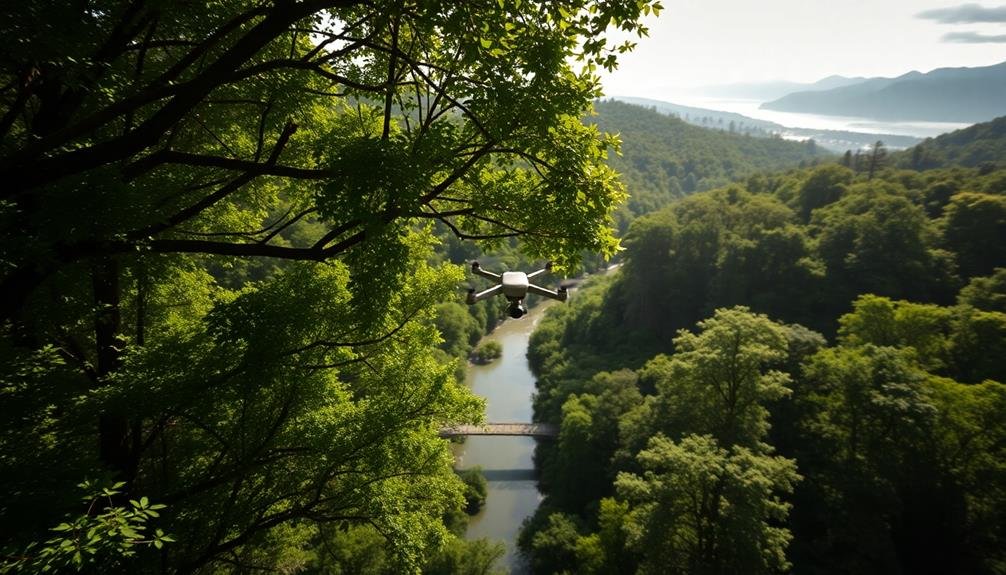
Numerous ethical considerations come into play when using drones for nature photography. You'll need to balance your desire for stunning aerial shots with respect for wildlife, the environment, and other people's privacy.
Always research local regulations and obtain necessary permits before flying. Familiarize yourself with no-fly zones and protected areas to avoid disturbing sensitive ecosystems or endangered species.
When photographing wildlife, maintain a safe distance to prevent stress or altered behavior. Be mindful of nesting sites, breeding grounds, and migration patterns. Your drone's noise and presence can disrupt animals, so limit your flight time and avoid repeated passes over the same area.
Here are key ethical practices to follow:
- Respect privacy: Don't fly over private property without permission
- Minimize environmental impact: Take off and land in cleared areas to avoid damaging vegetation
- Be considerate of others: Don't fly near other photographers or visitors enjoying nature
Sharing Your Aerial Nature Portfolio

Once you've captured breathtaking aerial nature shots and followed ethical practices, it's time to showcase your work. Start by curating your best images, selecting those that truly highlight nature's beauty from above.
Create a cohesive portfolio that tells a story or showcases a specific theme, such as seasonal changes or diverse ecosystems.
Consider various platforms to share your aerial nature photography. Instagram is ideal for building a following, while 500px and Flickr cater to photography enthusiasts. Create a personal website to display your work professionally and potentially attract clients.
When sharing on social media, use relevant hashtags to increase visibility.
Don't forget to include information about your drone setup, camera settings, and location details (if appropriate) with each image. This adds value for viewers and fellow photographers.
Engage with your audience by responding to comments and participating in online photography communities.
Submit your best shots to photography contests or nature magazines to gain exposure. You might also consider partnering with environmental organizations to use your images for conservation efforts, furthering the impact of your aerial nature photography.
Frequently Asked Questions
How Do I Protect My Drone From Wildlife Encounters During Flights?
To protect your drone from wildlife, you'll want to fly higher, avoid nesting areas, and stay clear of animals' habitats. Don't hover near birds or other creatures. Use quiet props and bright colors to make your drone more visible.
Can Drones Be Used for Nighttime Nature Photography?
Yes, you can use drones for nighttime nature photography. You'll need a drone with good low-light capabilities and a camera that performs well in darkness. Be sure to follow local regulations for night flights and wildlife protection.
What Insurance Options Are Available for Drone Photographers?
You'll want to contemplate liability insurance and equipment coverage for your drone photography. Many providers offer specialized drone insurance policies. You can also check if your existing homeowner's or business insurance extends to drone operations.
How Can I Reduce Propeller Noise to Avoid Disturbing Wildlife?
To reduce propeller noise and avoid disturbing wildlife, you'll want to use quieter drone models, fly at higher altitudes, and opt for larger propellers. You can also try noise-reducing propellers and plan flights during less sensitive times for animals.
Are There Special Considerations for Drone Photography in Extreme Climates?
When shooting in extreme climates, you'll need to protect your drone from harsh conditions. You should insulate batteries, use lens filters, and watch flight times. In cold weather, pre-warm batteries, and in hot climates, avoid overheating your equipment.
In Summary
You've now got the tools to capture nature's beauty from above. Remember to always fly responsibly, respect wildlife, and follow local regulations. As you soar, you'll discover new perspectives on familiar landscapes. Keep practicing, experimenting with angles, and refining your post-processing skills. With dedication, you'll create stunning aerial nature photos that showcase Earth's wonders in ways few have seen. So grab your drone, head outdoors, and let your creativity take flight!

As educators and advocates for responsible drone use, we’re committed to sharing our knowledge and expertise with aspiring aerial photographers.
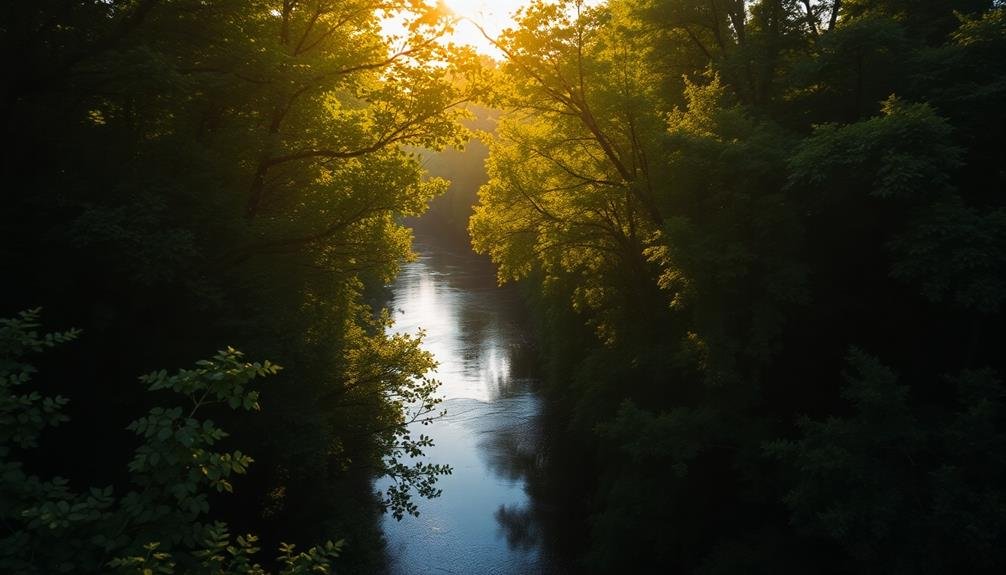



Leave a Reply